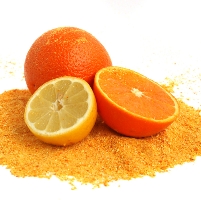Citrus peel shows promise in fish feed

South Korea produces an annual 40,000 tonnes of citrus peel as a by-product from fruit processing. Together with the dead fish waste from aquaculture production, the citrus peel can provide a valuable fish feed according to scientists.
The compounds found in citrus peel, known as polymethoxylated flavones
(PMFs), are antioxidants that belong to a group of plant chemicals called
flavonoids. Flavonoids exist in a variety of fruits and vegetables, as well as
tea and red wine. This fact made a research team at Cheju National University
look for producing high valuable fish meal from the citrus peel and the fish
waste. The research was led by Dr Seon-Heui Cha of the University’s Faculty of
Applied Marine Science.
Antioxidant activities
Dr Cha
and his team made two kinds of functional fermented fishmeal (FFM) from the dead
fish and citrus peel. One contained citrus peel, the other contained rice bran
but no citrus peel.
Statistical trials showed that the FFM containing the
citrus peel showed strong antioxidant activities against the DPPH free radical
(about 95%) and hydrogen peroxide (around 80 %) in a concentration of 4 mg/ml.
The FFM containing citrus peel also exhibited enhanced protection to flounder
leukocyte against H2O2-mediated DNA damage.
Tested in
fish
Two experimental diets were formulated for olive flounder (also
named Japanese flatfish). One pellet was a normal raw fish moisture
pellet. The second diet was the same but contained 7% FFM containing citrus
peel. The feeds including FFM enhanced the growth and significantly decreased
the mortality of the fish. Fish fed FFM had significantly higher lysozyme
activity and NBT reduction. Dr Cha considered that the results suggest citrus
peel containing FFM increased the immune response of cultured olive
flounder.











